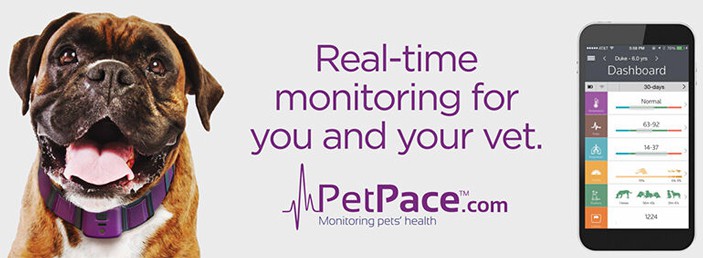Listen above or: iTunes / Spotify (Tap the subscribe button – it’s free and keeps you updated!)
Today’s Guest
Dr. Asaf Dagan: Intuitive Body and Behavior Tracking Dog Collar
I’m so excited to introduce to you today’s guest, Dr. Asaf Dagan, the chief veterinarian and co-founder of PetPace.
Dr. Asaf is a graduate from Tufts University and specializes in canine and feline medicine. As a vet he has a thorough understanding of how medical devices function and has used that expertise to help create a collar that is capable of collecting important data including heart rate, respiration, and sleep activity.
![]()
This technology is incredibly important as it’s a pioneer in detecting health issues in pets before they become a major problem. Of course, on top of the many medical benefits, these collars also have built-in GPS systems that help owners keep track of where their pets are—a major safety feature especially for pet parents that have pups that like to run!
If you love your pup and you love technology I think you’re really going to enjoy this latest podcast! Don’t miss it!
You’ll Hear About
- [01:00] Who is Dr. Asaf Dagan
- [01:30] What is PetPace?
- [03:30] PetPace Monitoring
- [06:30] Why PetPace Collars Are So Important
- [12:00] The Science Behind PetPace Technology
- [15:00] Activity Tracking
- [19:00] GPS Tracking Abilities
- [22:00] The Importance of Activity Tracking
- [24:30] Where to Get a PetPace Collar
- [26:30] Incredible Rhodesian Ridgeback Story
- [29:30] Use In Epileptic Dogs
- [31:30] HRV Tracking
- [33:30] PetPace Purchasing Information
Links & Resources
- Website: https://petpace.com/
Learn more by tuning into the podcast!
Thanks for listening—and again, don’t forget to subscribe to the show on iTunes / Spotify to get automatic updates.
Cheers,

~Doggy Dan
Dr. Asaf Dagan: | The thing is, not only they can't tell you, they won't tell you. They still have this animal instinct of not showing weakness or disease, because if they do, in nature, you don't survive, if you show weakness. So they still have that basic instinct. So by the time you notice that something is wrong with your pet and you take it to the vet, it's already an advanced condition. |
[00:00:30] Voiceover: | Welcome to the Doggy Dan podcast show helping you unleash the greatness within your dog. |
Doggy Dan: [00:01:00] | Hello and welcome everybody to another edition of the Doggy Dan podcast show. So today, I'd use the words intrigued and fascinated, because we have Asaf Dagan with us that I who's the co-founder and chief veterinary scientist at PetPace. Now a little bit more about PetPace in a minute, but just a bit of background on who Asaf Dagan is. He's basically he's demonstrated a long history of working in the medical device industry. He's a graduate from Tufts University where the deployment of the American Board of Veterinary Practitioners specializing in canine and feline medicine. So he understands medical devices. He understands veteran medicine and law Asaf Dagan, welcome to the Doggy Dan podcast show. |
Dr. Asaf Dagan: | Thank you very much. Thank you for having me. |
[00:01:30] Doggy Dan: | Yeah, no, I am honestly intrigued and fascinated. So my first question, which I'd like to start with, is what is PetPace as a company, as an organization and what do you do just to give people a bit of a heads up early on as to what it's all about? |
Dr. Asaf Dagan: [00:02:00] | So PetPace is a wearable device company for animals. It was launched in 2012, and we developed a smart collar that monitors the health and wellbeing of dogs and cats, and hopefully in the future, other species as well. |
Doggy Dan: | So I love it. And my mind immediately goes, so when you say it's a wearable device, that measures stuff, what exactly can it measure? Because I'm sure people are thinking, “Well, how, how smart can these devices actually be?” |
[00:02:30] Dr. Asaf Dagan: [00:03:00] | So they're actually pretty sophisticated. It's a collar that you put on a neck of a dog or a cat, just like you would any other collar. You don't need any special preparations or shavings, but it has a very sensitive sensors on the inside of it, which captures a wealth of information, physiological and behavioral information. So we can tell their temperature and their pulse and their respiration and their movements and whether the lying on the right side or the left side, we can tell everything they do. And on top of it, we have a very sophisticated analytic engine that uses machine learning and AI to understand the meaning of this data, and then concluding whether there's any change in the health or wellbeing or routine of your pet, which may indicate a change in their health status. |
Doggy Dan: | Wow. So can we just go through them because I am fascinated. I mean, you mentioned temperature. I mean, temperature is pretty basic, I guess, and I guess it's pretty accurate. |
[00:03:30] Dr. Asaf Dagan: [00:04:00] [00:04:30] | Yeah. So just like, think about if you ever went to the doctor yourself, what would be the first thing that they would do to assess your condition? They will take what's called in the medical jargon, TPR, temperature, pulse, and respiration. These are called the vital signs. These are the basic physiological parameters that there's hardly any disease that would not cause at least one of them to be altered. So this is really the basic of any medical evaluation. In addition, we also measure activity, because it also tells you something about the routine and the wellbeing and the health of your animal. The position data is interesting as well, because very quickly, once you start wearing the collar, you can see the routine and the preferences and each dog has their own preferences. So if one dog is used to lying on the right side, and then suddenly you notice that he's not doing it anymore, that may indicate that there is a pain or discomfort on that side. |
We also monitor their quality of sleep through a looking at how often they wake up in the middle of the night, et cetera. So the idea is to collect a lot of data points, and then combining them together to create patterns that indicate the health and wellbeing of your animal. | |
[00:05:00] Doggy Dan: [00:05:30] | Wow. I don't like my own activity being monitored too closely, but one I have had monitored is my sleep activity. I was fascinated with how accurate it could monitor how well I was sleeping. And I had an app which measured kind of the movement of my head on the pillow. I think it was that's how it did it. I was blown away with how accurate it was. It literally knew whether I'd had three kind of major times that I woke up in the night for whatever reason or whether I slept really deeply solid through the night or whether I was kind of light sleeping. It was so accurate, I couldn't believe it. So in terms of believing that this is possible yeah. With the activity and stuff, I'm kind of going, “Yep. I can believe it.” |
Dr. Asaf Dagan: [00:06:00] | The great revolution of their wearable devices, because you can take very accurate sensors and put them in a very small device that you can wear on your body or on your putting on your pet's neck and it's accurate as a medical device and we have gone through extensive and exhaustive verification and validations by talking universities and governments in around the world. And we are over 90% accurate across the board. |
Doggy Dan: | Wow. Because the big difference, I guess, for me with dogs and humans is the dogs don't have any way of telling as they have a headache or the temperature is high or they feel sick. |
[00:06:30] Dr. Asaf Dagan: [00:07:00] [00:07:30] | Correct? The thing is not only they can't tell you, they won't tell you. They still have this animal instinct of not showing weakness or disease. Because if they do, in nature, you don't survive if you show weakness. So they still have that basic instinct. So by the time you notice that something is wrong with your pet and you take it to the vet, yes, it's already an advanced condition. It means it doesn't, it's not capable of hiding its symptoms anymore. So this is actually, it's a good point, because this is actually the essence of why we started PetPace in the first place. As a veterinarian, to me, it was all always very frustrating to have people come in and they just noticed that something is off with their dog or their cat. They're not eating as well. They're not as active as they used to be. They attributed it to their age or to whatever. But at some point they say, okay, let's take it to the vet. And then you check it. |
[00:08:00] | And it's already had a very advanced condition, cancer spread all over or diabetes, that's causing their entire system to go out of whack. And it's not because they're about owners. It's because the pets themselves did their best to hide their symptoms until they couldn't do it anymore. So the whole idea is that if we can measure the same parameters that, when you go to the vet and you check them they're off. So they started to be off sometime before that. So if you monitor these same parameters over time, the minute they go out of the normal boundaries, the very early signs of going out of normal health, you can pick that up and do something about it without waiting for the dogs to show symptoms. And that's the essence of what we do. |
Doggy Dan: [00:08:30] [00:09:00] | Yeah. I can so relate to that. I mean, the number of times where my wife and I have looked at our dogs, or even in the past our cats, “Oh my God, I think there's something wrong.” And like you say, you take it to the vet. And the poor animal is as sick as a dog, not wanting to use a pun, but I think that's why we say the word, “Sick as a dog,” because when a dog is sick, they are really sick probably, because of what we've just discussed. And you do, you feel for the dog, they've obviously been really sick. Haven't been able to say anything to you, but yeah, heart rate's up, temperatures often up, often start breathing heavily as well. And I guess, the pulse of the heart as well as not something we can easily measure, but if you have a, I guess if you can go back over time, you know what the standard heart rate is, and then you can notice it's the resting heart rate's changed. Is that how it works? |
Dr. Asaf Dagan: [00:09:30] [00:10:00] | Exactly. So that's another very powerful revolution that medical device in general bring, and that it's called in the medical field, if you read the journals and the trends that are going on, it's called personalization of medicine, because as opposed to just looking at the generic pulse range, like you mentioned, so, a normal dog has a pulse between 60 to 120. This is what the books say. But when you have a device on an individual dog and you'll learn it over time, you realize that its real range is maybe between 65 and 75. It's not as big. So as soon as they deviate from it, let's say now the resting pulse goes up to 80. That may be within the normal generic range. But for that individual dog, it's a 20 or 30% increase that may raise a flag and have you go and check what's going on. So the personalization is a big key in the early detection of medical conditions. |
Doggy Dan: [00:10:30] | And I'm thinking, especially if you know your dog is meant to be kind of a relaxing and quiet, maybe because they've just come off the back of some surgery or something, and you want them to be relaxed if you certainly know the heart rate is up to 80, 90, 100, you probably can, I guess, can you set these things so that it sets off alarms? |
Dr. Asaf Dagan: [00:11:00] [00:11:30] | Yeah. So the system comes with default sets of alerts and they automatically adjust based on how the system learns the individual values of each individual pet, but you can override it and set whatever thresholds for alerts you want. It completely customizable. It can also send alerts to whoever you choose. It could be the veterinarian or your dog-sitter or whatever. So, and you're right. I mean, you're bringing in another important point, we talked about early detection, but the other side of using wearables is to monitor an existing condition. So you can see if your dog or cat already have a medical condition or their after surgery, you can see how they respond and how they improve over time. So again, going back to the position example, if they had the surgery on the right knee, and now they start gradually to spend time lying on the right side, you know they're feeling better. PetPace is also unique with its ability to detect pain. We're actually the first time in the world that we have an objective way to assess pain, to detect and assess pain in animals. |
[00:12:00] Doggy Dan: | How on earth does that happen? Yeah. |
Dr. Asaf Dagan: [00:12:30] | So we did a very extensive study with a university in the U.S., North Carolina State University. And we had a group of dogs with arthritis, osteoarthritis. It's a degenerate disease of joints that virtually every dog gets at a certain age. And then we compared it to a group of control, healthy dogs. And then we found more than 20 individual features in the data that separate the two groups. In other words, we now know how the biometrics of a dog with pain looks like compared to a dog that does not have pain. And that's virtually you build an algorithm based on that. And now any dog that would wear the collar within two weeks, we can tell whether they have a pain and arthritis or not. |
[00:13:00] Doggy Dan: | Wow. Fascinating, absolutely fascinating. And all of this I've been on your website. So I kind of know how this works a little bit, but for those people who are still trying to figure it out in their head and they're driving along going, “So where do you see all this?” This information all comes out on a kind of an app on your smartphone is one place you can get all that information- |
Dr. Asaf Dagan: | Correct. |
Doggy Dan: [00:13:30] | To be shown. Is that right? Is there other places, I mean, it can be sent to your vet as well. Somebody can monitor it for you if you don't want to get into the nitty-gritty data yourself, is that right? |
Dr. Asaf Dagan: [00:14:00] | Yeah. So we have a mobile application, as you said, we also have a web application and you can use them. You can share them with your veterinarian. You can generate reports that kind of summarize periods of time, and you can share that to your veterinarian. And pretty soon we are in the process of actually developing our next generation collar. And in the next generation collar, we will have even more advanced analytics where you can, for example, you can mark times when you gave your pet certain medications or treatment, and it will automatically analyze the data before and after giving the treatment. So you can see the effect. And if you don't see the desired effect, maybe you need to make some changes, maybe increase the dose or change the type of treatment you're giving to get to the desired effect. So there's a lot of analytics that are still coming down the way. |
[00:14:30] Doggy Dan: | Wow. There's just so much stuff to discuss. I mean, it's incredible. One of the things I'm always interested in is the activity. The activity side of my dogs, how far they're traveling, where they go, what they do? What's covered in of kind of tracking the dog and maybe location or just calories burned? I know, I think that's covered off as well. |
[00:15:00] Dr. Asaf Dagan: [00:15:30] | Yeah. So we look at activity in multiple ways. First of all, we just measure the amount of activity. And we tell you kind of on a timescale when the dog was active during the day and when it was resting. And we can also build a routine on that. So with sometimes after following the dog for some time, we can tell you, what is the average activity for your dog per hour of the day? So your dog may wake up, I don't know, 7:00 AM go on a walk and then dose off until the afternoon walk or whatever. So you have a routine. And now if they deviate from the routine that may indicate again, a change in their health status, we also count all the movement and give points where we give a it's done in a differential way. So we give more points to high activity as opposed to low activity, which allows you at the end of the day to get a number that is on a, just mathematically speaking it's on a normalized scale. |
[00:16:00] [00:16:30] | So it allows you to compare the activity of today compared to yesterday or last week or last month, or compare activities of different dogs, which again, tells you something about the level of activity. And a new feature that we just, we are launching now, we just completed a big study with biomedical engineering department of Tel Aviv University is the fitness score. So sort of like your Fitbit watch, when you go running, it kind of tells you how good your exercise was. We're doing the same thing now with dogs. So when you go on a walk or you go to the park with your dog, it will tell you the level of physical activity, not just whether they were active or not, but looking at the pulse and see how much exertion they use during this activity will tell you the quality of their exercise. |
Doggy Dan: | Wow, phenomenal. |
[00:17:00] Dr. Asaf Dagan: | It's really endless. I mean, once you have all this type of data, it's just endless of what you can do with it. This is for me personally, this is my passion in this thing is the ability to provide so much new knowledge that we just never had, because we never had access to this type of data before. |
Doggy Dan: [00:17:30] | No, I mean, it's always one of those things when you're not looking, the dog seems to behave differently. As a dog behaviorist the number of times I've got my camera out and as soon as I'm consciously watching the dog, the behavior changes. |
Dr. Asaf Dagan: | Of course. |
Doggy Dan: | Literally just watching changes what's happening. So when you're not even in the room, goodness knows what's happened, but that's the whole mystery. You put a camera in, you can see what the dog does and they behave differently. And it feels a bit like that, that when they're out of sight, go around the side of the garden or when you're not at home, watch really going on and you kind of get to see all of those strange behaviors from a respiratory and heart rate and temperature, all that stuff. |
Dr. Asaf Dagan: | Absolutely. |
[00:18:00] Doggy Dan: | Calories burned. How they're fascinating. How far can you actually monitor them from kind of your home base? Does it work? Is it to do with home base or was it done through satellite or how? |
Dr. Asaf Dagan: [00:18:30] | Yeah. Good question. So, right now, in the current version, which is the first version, you have a home antenna, which is all the installation you need to do is just connected to your home router and that will monitor your dog. If your dog roams away from home, take it on a long walk or something, the data is not lost. The collar still stores the data. And once you come back home, it will download everything. In the next generation collar that will come out next year, we will also have Bluetooth and wifi and a SIM card inside the collar. Was actually going to be smaller, but we're going to have a lot more stuff in it. So you will be able to get real-time data wherever you are. You're not going to be dependent on your home base anymore. |
[00:19:00] Doggy Dan: | Wow. Does it actually plot the position of a dog? Can you see on a map sort of thing? |
Dr. Asaf Dagan: [00:19:30] | Yes, we will have a GPS. We don't have it in the current version, but the next generation collar will have a GPS in it. So you'll be able to do a few interesting things. One is just know where your dog is, but you can also set a boundary it's called geo-fencing. So you can set a boundary on the map, like your home or around your home in the yard. And as soon as the dog breaks the boundary, you will be alerted that your dog just run out of the yard or whatever. And then you can go into the third feature, which is called find my pet. So you'll be able to track them in a high-resolution and quickly find where they are and, and get them back home. |
Doggy Dan: [00:20:00] [00:20:30] | Wow. Are you hearing this guys? I mean, for anyone who's ever lost a dog, what would you pay for that to be able to locate your dog, locate my dog? That's just awesome. I must be honest. I've had a dog who was a real. No, she wasn't a real roamer, but when she went, she really went and she just used to love to run. And I get the feeling she could do maybe sort of five to 10 kilometers an hour. And there's once she went missing for sort of five hours. And I have no idea where she went or how far she went, but I would love to know. I would love to know how far did she go? How many kilometers? Because it feels like she did sort of 40, 50 kilometers. |
Dr. Asaf Dagan: | Wow. |
Doggy Dan: | I may be wrong. I probably am, but- |
Dr. Asaf Dagan: | But that's impressive. |
Doggy Dan: | I know how fast she could run and she had endurance. I mean, I've had a few dogs in my time, but this one was a triathlete. She was a marathon runner. Yeah. It'd be fascinating. And I guess, to get the temperature and the pulse of our heart rate and the respiratory the whole time kind of fascinating. |
[00:21:00] Dr. Asaf Dagan: | Yeah. So this goes back to the fitness feature that I mentioned, which can be very useful. So a lot of people are now running with their pets and exercising with them and even going to races together. So that can be very useful or sled dogs racing, could be very useful for them to build their fitness and physical activity and then, if the fitness level, in other words. |
Doggy Dan: [00:21:30] [00:22:00] | I guess, there's so many different places and areas where it can be of benefit, because as we mentioned before, the dogs can't tell us when, for example, they're being over-exercised. I mean, the number of times I've seen a dog and I'm like, I'm thinking, “That dog shouldn't be exercised like that. It's too much strain on the heart is my guess, there's a lot of people around here, they put their dogs, they get in the car and they drive down the beach and the dog is meant to run behind the car. And I know that the dog will not stop, even if it's about to have a heart attack, it will keep trying to keep up. And I think, people would go, “Oh my gosh, maybe we're over-exercising our dog.” |
Dr. Asaf Dagan: [00:22:30] | Yeah. Yeah. And actually, this is also very interesting to working dogs. So we have a lot of interesting clients from military and government agencies, where they use dogs that are extremely motivated and they won't stop until they drop. And these are very valuable animals. So this is very valuable for them to be able to monitor and stop them before they get to a danger zone, because the dogs won't stop themselves. Somebody has to stop them. |
Doggy Dan: [00:23:00] [00:23:30] | And I guess, it also gives people an understanding of just how stressed that dogs are in terms of the pulse of the heart rate. I'm getting interested in now, because I often say to people, one of the biggest mistakes we make is dog owners don't recognize how stressed their dogs are. And I can see it because I can see their mouth is open, the tongue is out, the dog is panting, and it's cold, it's a cold day. It's not hot. The dog hasn't exercised, it's cold in the house and the dog is panting like that, because I know the dog is stressed. And I think this would probably highlight it to people, because they'd see it as a heart rate and they'd go, “Wow.” They know what their resting dog's resting heart rate is. And they'd realize, “Yeah, the dog's done nothing for two hours and its heart rate's right up.” Is that fair to say? |
Dr. Asaf Dagan: [00:24:00] [00:24:30] | Yeah. So one of the parameters that we measure is called HRV, heart rate variability, and it's essentially, it measures the time intervals between consecutive heartbeats. And it turns out that what controls this variability is the type of, or the part of the nervous system that's called the sympathetic nervous system. It's the same part that goes into work when you're in fight or flight mode. In other words, when the dog is stressed, this number, this HRV changes. So again, we have, for the first time, we have an objective marker for stress in animals. And there are a lot of studies in universities all over the world that looks into using our collars that look into stress in dogs. Some are already published and some are still in the works, but understanding anxiety and stress is really being revolutionized using HRV, which are our collar can provide. |
Doggy Dan: [00:25:00] | Wow, fantastic. So for people who are interested, how would you say people who are just they're listening to this and they're thinking, “I want to know a bit more.” Would you recommend they jump on your website? Is that the best place to go? Or how would they go about it? |
Dr. Asaf Dagan: [00:25:30] | Yeah, sure. So you can go to petpace.com and read about the collar and some of the things that we're developing. And if you want to order, we also have a shop and online shop and yeah, we can provide whatever support or answer whatever questions people may have and pretty, pretty, simple and easy. We sell virtually all over the world from North America and South America, all the way to Australia and New Zealand and pretty much everything in between. |
Doggy Dan: | And they're pretty simple to use. You literally get the collar and it explains how to put it on your dog and link it up to your phone. Is that pretty much the basics of it? |
Dr. Asaf Dagan: [00:26:00] | Yeah. We really try to make it dummy-proof. So all you have to do is just connect the antenna to your home router and place the collar on your dog and you're good to go. And if there's any difficulty whatsoever, we have customer support that will help you through it. |
Doggy Dan: | Well, sounds great. I guess a lot of people who have got these have been they've had surprises in terms of what the dogs are actually maybe experiencing. Is it fair to say that people sometimes get a report back, which they had no idea the dog was either- |
[00:26:30] Dr. Asaf Dagan: [00:27:00] | Yeah. So I can tell you an interesting story from a breeder of dogs of, I'm blanking up now on the breed, the Rhodesian Ridgeback sorry. So this dog is a champion over the head to the two litters before and now she's going through the third pregnancy. And she's taking part of our pregnancy study. So she's wearing a collar and the collar keeps sending her alerts that something is not right. And this is a very diligent owner, very sophisticated knows about dogs. And she takes the dog to the veterinarian multiple times during the pregnancy. And they do all the blood tests and the ultrasounds and everything. And everything's fine. They couldn't figure out what's going on and why the collar's still alerting her. Well, she goes into labor, she's finishing her two months. She goes into labor and it doesn't go well. |
[00:27:30] [00:28:00] | So they rush her to the vet and they do a C-section and when they open her up, the veterinarian kind of takes a look around and doesn't like the way the liver looks. So he takes a biopsy from the liver and it comes back is a very bad liver disease, very chronic, but microscopical disease in the liver. And they had to stay her at this part. She will not be able to have any more litters, but she was lucky, because if she had another one she may have died. And the thing is that the collar pick these things up even before blood tests and ultrasound and all the other things, because they only see things from a certain level up. But if your body's fighting something, even before the blood test changes, even before the ultrasound shows anything, that your physiology is already showing it. Yeah, and this is the power of the collar for him to have early detection of diseases. |
Doggy Dan: | And so, would it have been kind of a combination of the temperature that, the pulse and the respiratory all combined to setting off an alarm? |
[00:28:30] Dr. Asaf Dagan: [00:29:00] | Yeah. So in this case it was specifically the HRV that kept firing alerts, but you're right. It's usually a combination of things that indicate that something is not right and it's not diagnostic. It's not going to tell you the exact type of disease the dog has, but it will tell you that something is not right. And together with a veterinarian, they will be able to find out what's going on and what to do about it. And again, a big part of what we're doing now, where our efforts are, is to develop specific disease programs, the ability to detect specific diseases and then manage them. And the diseases that are first on our pipeline are epilepsy and detection of parturition during pregnancy and cancer. And we'll continue from there. But these are the first ones that we will launch in our plan. |
[00:29:30] Doggy Dan: | Well, the epilepsy one is, I guess it's an early warning signal that something's not quite right. It picks it up quite quickly, I guess, is that? |
Dr. Asaf Dagan: [00:30:00] [00:30:30] | Yeah. One of the big issues with epileptic dogs is that it's very important to know how often they have seizures. And we are all busy and we go to work and do school and whatever, we don't always have an eye on our dog. So we don't really know how many events they have. And this is a crucial piece of information, because that what's dictates the type of treatment that you would get and the collar, we don't have it yet. We're still studying it. We're still in the development phase, but it already shows that we can pick up an event like a seizure. We can see how it looks like in the data. We can develop the pattern. And then, once it's finished, you will have a feature on your application that will alert you when your dog show signs that are typical of a seizure event. |
Doggy Dan: | I guess it comes back to that what we mentioned earlier that the dogs can't tell you, they've had three epileptic fits in a day. |
Dr. Asaf Dagan: | Exactly. |
Doggy Dan: | You come home, they look fine, but it's been traumatic. |
Dr. Asaf Dagan: | Exactly. Yeah. |
Doggy Dan: [00:31:00] | I was just thinking another area, which I'd be fascinated in is a lot of the work that I do is about calming dogs down, getting them to relax. And often again, people, they find it hard to see that their dog is calmer until it's really obvious. But with something like this, you'd be able to measure the pulse of the heart rate, the respiratory, the activity. |
Dr. Asaf Dagan: | Yeah, exactly. |
Doggy Dan: | Yeah. And people will go- |
Dr. Asaf Dagan: | HRV. |
Doggy Dan: [00:31:30] | HRV, and they'd say, “Hey, he's calmer today than yesterday.” And that would actually encourage people. So I'm kind of thinking from a behavioral point of view, we often need to give the owners encouragement that what we're doing is working and sometimes that HRV would probably be, because if the behavior, if the dog doesn't do anything wrong, like it doesn't bite anybody on a regular basis, which obviously never happens. You don't have a dog regularly biting, it's hard to see if the dog is actually more relaxed and if all the chemicals in the body are starting to, the right ones that you don't want to be firing all the time are actually dropping, but this would actually give you that measure. |
Dr. Asaf Dagan: [00:32:00] [00:32:30] | Yeah, there's actually a study that's coming out now. It was done in Australia. This is, it was done by a researcher, a lady who developed calming music, music with that supposed to have calming effect on dogs and cats. And the study was on cats. They took, I think, nine or 10 cats in Australia and each wore the collar and at certain times they played the music to them and then were times where the music did not play. And then, we compare the data between the two periods of time. And you can see that when the music was played on average, the pulse was lower, HRV was better, activity was lower. So all these different attributes that show that the cat was more relaxed and calmer. So you're right. This is a tool that will tell you whether what you're doing is working or not. And if not, then you can modify it until you get the desired effect. |
Doggy Dan: [00:33:00] | Yeah. Oh, that's brilliant. It's independent. It's not measuring your placebo. It's measuring the real facts about how your dog is behaving and feeling. |
Dr. Asaf Dagan: | Exactly it doesn't have the white coat effect, right? Once you go and actually measure your dog pulse, you're already changing it just by the fact that you're interacting with it. |
Doggy Dan: [00:33:30] | Wow. Wow. What can I say? I'm fascinated. I want to get my hands on one. I want to see how my dog behaves and what they're doing. Well, so for anybody who's interested, pace.com. So P-E-T-P-A-C-E . com. I'll put all of this podcast up on our website as well. So theonlinedogtrainer.com/petpace. And yeah, I fully recommend you go to the website, check it out and have a nosy around, there are some lovely case studies. And it talks about the pet health monitoring as well, because you offer that it seems like as a service. Is that something, is that right? |
[00:34:00] Dr. Asaf Dagan: | Yeah. So when you buy the collar, you also subscribe to the service that gives you the alerts and the data and all the analytics that's involved. And you can renew it from time to time. And it's not too expensive. It's around $200 U.S. a year, including the collar and the service. |
Doggy Dan: [00:34:30] | Yep. Great. So for $200, you really can know what's going on with your dog, which is a fraction of the, if you think of what you actually have to pay, when it goes really wrong, it's a fraction of that cost to be able to step in early. And yeah, it's quite fascinating what we're able to do with all the new technology. |
Dr. Asaf Dagan: | Absolutely. |
Doggy Dan: [00:35:00] | What can I say, Dr. Asaf Dagan, it has been absolutely wonderful to have you on the podcast show today. And yeah. For all of you people listening, if you're thinking, “What's going on with my dog, why is he doing that?” Is he okay if you're concerned that this may be something going wrong, or you just want to kind of know that he's well, or is he improving either from a behavioral point of view or a health aspect, then yeah. Check out this website, petpace.com and yeah, absolutely fascinating. It's been an absolute privilege to have you on the podcast show today. Thanks for joining us. |
[00:35:30] Dr. Asaf Dagan: | Thank you very much for having me. I appreciate it. I had a lot of fun and thank you again. |
Doggy Dan: | Yeah. Okay, guys, have a great day. And as always love your dog. |
Voiceover: | You've been listening to another episode of the Doggy Dan podcast show, bringing you one step closer to creating harmony with your dog. |
Sign up to receive email updates
Enter your name and email address below and I'll send you periodic updates about the podcast.














